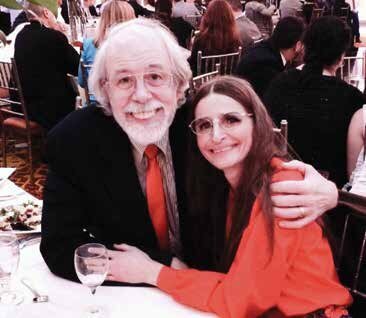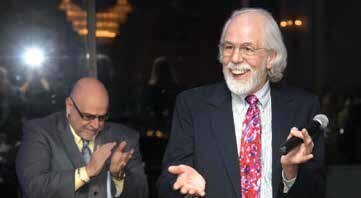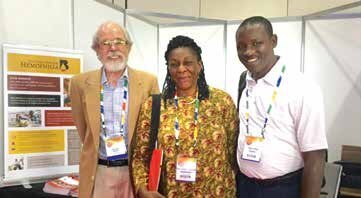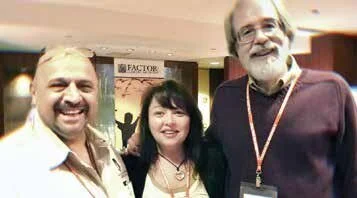“The Opportunity Of My Life” Getting To Know Dr. David Clark (Copy)
Readers of The Coalition for Hemophilia B’s quarterly publication, Hemophilia B Newsletter (formerly Factor IX Newsletter) have seen many a byline reading “By Dr. David Clark” for Treatment News, Research Update, Women with Hemophilia, Hemophilia Health News, Emerging Therapies, and other features. An active Chairman of the Coalition, Dr. Clark regularly participates as an educator at US-based events and attends national and international meetings to keep current on the hemophilia front.
Dr. Clark’s articles offer cutting-edge hemophilia B information and help readers become better advocates for themselves and their families. Dr. Clark is a veteran and expert in hemophilia research, product development, and reporting. His wealth of knowledge might seem imposing, but those who know “Dr. Dave” describe him as humble. Indeed, that is how he struck me during our interview. “I tend to be very shy,” he shared, “but I enjoy attending Coalition events and interacting with everyone. Being with the community tends to bring me out of myself a bit.”
It has been the good fortune of the Coalition to have Dr. Clark onboard since its inception. As we mark the thirtieth anniversary of the Coalition, we wanted to shine a light on the person who has been helping us become more knowledgeable. We sat down for a Zoom interview to discuss his interesting background, expansive and varied professional path, concerns, and all those pearls of wisdom, drawn from his personal experiences and from his interactions with parents and their children.
Dr. Dave and Linda married for 27 years and going strong! They love traveling, hiking and spending time in nature.
“I grew up fairly poor in Ohio. It was education that brought me out of that and to where I am today!” I received a very good education through the Akron public school system. He remembers enjoying his high school chemistry class. “I was already into science. The whole country was big into science those days. Our country’s interest in science was spiked with Russia launching Sputnik, the world’s first satellite. Being competitive, the US was highly motivated at the idea of no longer being the number one superpower. Russia was in space, and we weren’t - we were going to the moon!”
Although Sputnik was a great motivator, Dr. Dave believes getting children involved in science at an early age is important and easy to do, “Kids get really interested in science, especially natural science: wandering in the woods, looking at everything, learning about plants… and then there’s dinosaurs and outer space…” Clark shifts his focus to parents, “There are all sorts of ways parents can get their children interested in science and that can be a great thing for their long-term success.”
Dr. Clark points to a singular moment in his youth that set a trajectory toward a meaningful path forward, “My high school held an event where representatives from big colleges came to recruit students. One woman talked about Cornell University… I didn’t expect to get in, but I applied on a whim. Not only did I get in, but they gave me a full scholarship! It was the opportunity of my life! I could never have afforded to go to a school like Cornell on my own. It pulled me out of life as a poor kid and took me to a future of all sorts of amazing things.
“My advice?” he asks. “Find what you’re interested in and learn more about it.” Dr. Clark realizes certain subjects may be more challenging to some, but he says, “Don’t be afraid of education. Don’t say, ‘I don’t understand math.’ The whole purpose of education is to help you understand.” He recommends trying them on a small level to see if you have an interest and an inclination toward those subjects.
Fully enjoying his undergrad experience at Cornell, Dr. Clark went on to earn a master’s and PhD there as well. “After earning my PhD, I looked for a job.” It was a difficult time. He sent more than a hundred letters to prospective companies but was able to land only 10 interviews. Of those, he was offered one job. It was a postdoctoral fellowship at Textile Research Institute in Princeton, NJ. There, he worked on the wetting and absorbency of fabrics, “We did some interesting things. We worked on baby diapers, tea bags, and all sorts of fabrics and fibers that soak up liquids.
Dr. Clark retraces the steps of his unlikely path. “Next, I got a job at the National Bureau of Standards outside of Washington D.C. This was during the energy crisis in the 1970s and Congress had awarded funds to work on rerefined motor oil, basically to clean and reuse it. Given the hefty funding, we had all the latest equipment and could do amazing things! It was a pretty cool thing! Although I hadn’t done anything in analytical chemistry before, the people I worked with were analytical chemists and I learned an amazing amount from them.”
“After that, I worked for the dean of research at George Washington University (GWU). He had a little research group on the side where we worked on artificial hip joints.” The experience led to another job where Dr. Clark worked on artificial kidneys. “I kept getting into these new fields and that really helped me have exposure.... It really helps as a researcher because with each experience you’ve learned a lot and that experience may point you toward solving the problems you’re currently working on.”
The pinnacle of Dr. Clark’s career began in the early 1980s with a twenty-year stint working for the Red Cross, where his work with hemophilia centered around developing new products. He looks back at that time with fondness. “My boss at the Red Cross was Dr. Doris Menache. As a young physician in Paris, France, she had been part of a group that developed the first factor IX concentrate, Coagulation Factor IX. This was a big deal at the time, but the problem was it couldn’t be used in very large quantities. For instance, prophylaxis was not an option. It was also proved to be very dangerous in surgery because it could cause thromboembolic complications,” a clot inside a blood vessel could break loose and stop the flow of blood.
Dr. Menache and the research group were seeing a lot of success treating bleeds with this product. Unfortunately, as the first to use it in surgery, Dr. Menache’s patient died. The heartache she experienced over this loss ignited a life-long mission to develop a safer factor IX concentrate.
This work led her to the United States and to the Red Cross where she set about to working to accomplish her goal. Knowing of her work, Dr. Clark was energized to be a part of her team. He reveals, “The first project I worked on was trying to create a better factor IX concentrate.”
At the time, Baxter was contracted to process all the Red Cross’s plasma. As part of that, the team was able to use their research facilities to work on the factor IX concentrate. The Red Cross had never developed a product like this before. A pharmaceutical company might typically have a team of fifty people working on such a product, but the Red Cross team consisted of Dr. Clark and just a few others.
“We weren’t really sure what we were doing, and we didn’t have enough people to do the work, but we pushed ahead anyway. Despite the challenges, we did very well,” Dr. Clark shares, “We developed the product, figured out how to produce it on a large scale, and began clinical studies. We were able to show this product did not cause thrombosis. It was successful.”
At the time though, there was no time to celebrate their victory, as the AIDS crisis took the world by storm. Medical minds were directed toward finding a cure or at least finding relief for this mysterious virus. Dr. Clark recalls, “We had to scramble to come up with viral inactivation methods. Baxter had been developing a dry heat method for inactivating HIV and other viruses in their products and we were able to apply that method to our product and it worked.”
Another important element of their process was maintaining the transparency the Red Cross espouses. “We were very open about what we were doing. I held many discussions in multiple settings about our progress in the development and purification of our product,” Dr. Clark explains.
“Though we were unable to get our product licensed, I believe our influence had a lot to do with the development of safer factor IX products.” Naturally, commercial pharmaceutical companies picked up on the excellent work Dr. Menache’s team was doing. Alpha Therapeutics soon came out with AlphaNine, which was inspired by what the Red Cross team developed. It was approved for use in 1996 (Alpha Therapeutics was acquired by Grifols in 2003).
“This was fine with us,” Dr. Clark commented, “We just wanted patients with hemophilia B to have a safe product.” The Red Cross then collaborated with Alpha using the plasma they collected to make their product. Another company, Armour Pharmaceutical (now CSL Behring), was next in line to develop Mononine, another highly purified factor IX product that was safe from thrombosis. Dr. Clark remembers the satisfaction he felt, with the knowledge that there were now at least two safe products for patients with hemophilia B.
“It was an amazing experience,” Clark recalls with gratitude. “They were all research scientists and biochemists. They hired me as a chemical engineer to try to make this product on a large scale. I had no idea that this is what I was going to be doing, but it turned out to be such a wonderful thing, and I learned so much from all the people and the projects we worked on.”
The gratifying experience with the Red Cross would be part of a recurring theme in Dr. Clark’s professional life. It is a theme he embraces and encourages others to be open to in their lives. “What I really wanted to be was a physical chemist, but I became a chemical engineer to make a living. It turned out to be a great path for me because I found it hands-on and useful. A chemical engineer gets a basic background in science and engineering and with that experience can really do well in a lot of different fields.”
Following The Red Cross, Dr. Clark went to work with Clearant along with several people who used to work for the Red Cross. Using radiation to kill viruses, Dr. Clark found this work fascinating, “We did a lot of work on plasma products, but mostly worked with donated human tissue products.” After Clearant, Dr. Clark became an independent consultant for a few of the tissue banks. “This was a whole different field, but it was related to plasma in that it’s material that comes from human bodies.
The primary company with whom Clark worked as an independent consultant was Tissue Banks International in the San Francisco Bay area. As part of this work, he and a friend developed methods for sterilizing tissue using radiation. They improved upon the methods he’d learned during his time at Clearant.
A spark was clearly ignited as Dr. Clark relates this introspection about his journey, “This is my life story, and this is what I want to emphasize. In my career, I’ve jumped from one field to another. Again, it’s about education. If you have a good education, you realize you can learn more and become comfortable and well-versed in a new field.”
With a nod of energized satisfaction, he says, “You also find a lot of the experiences you’ve had in the past are valuable to what you’re doing now. People might call it ‘thinking outside of the box,’ but it’s really thinking in terms of the boxes you’ve been in before. You’re in a new box, but you have ideas to add from the older boxes.”
I muse about the wonderful aspect of Dr. Clark’s life taking him on paths he could not have foreseen while he was a student in school. “Yes!” He exclaimed, “The big thing back in grad school was all this bio stuff, but I never wanted to do what everyone else was doing, so I decided I wasn’t going into biochemical engineering. Well, here I am now,” he laughs with a self-effacing shake of the head, “I’ve spent most of my career as a biochemical engineer. It just goes to show you never know where you might be heading. My philosophy has always been, ‘Don’t try to decide where you’re going. See where life takes you.’ Life has taken me toward all sorts of interesting things and places.”
“Sometimes I get criticized because people think you need to set a specific goal and work towards it. I’ve never done it that way, instead, going where life has led me. This approach has taken me to places much better than any goals I would have set for myself.” It’s unusual advice and Dr. Clark concedes that many parents may not want to hear it. “I’m different, but I don’t know my way is necessarily a bad way.”
I asked Dr. Dave how he came to work with The Coalition for Hemophilia B. “One of my later lab heads at the Red Cross was Dr. Bill Drohan. He was the head of the plasma derivatives lab and was a great guy to work for. He was always guiding us toward new ideas such as recombinant and transgenic products, which are not made from human blood.”
Dr. Drohan met John Taylor, founder of the Coalition, and began writing articles for the Factor IX Newsletter (now called Hemophilia B Newsletter). He soon enlisted Dr. Clark’s help, eventually turning the task over to Dr. Clark entirely. “I’ve been writing for the newsletter ever since,” Dr. Dave says with a big smile. “I never thought I could write but learned I have a knack for it. Someone once told me that to do a good job, I need to know my audience. So, I try to write as though I’m speaking to a parent of a young child with hemophilia, who may have limited medical knowledge along with limited time and wherewithal to figure out the technical verbiage.”
Concentrating our conversation on hemophilia B, I ask Dr. Clark if he has any frustrations or concerns. He states emphatically that he is concerned with the plight of women with hemophilia and wants to see them receive more recognition and not struggle to be diagnosed. “There are excellent treatments for hemophilia and better ones coming down the pipeline. No one should be bleeding and yet, many women are being ignored and having trouble finding appropriate care. These women are suffering, and they don’t need to be!”
I asked Dr. Clark where he thinks the root of this mindset stems from. “It’s part ignorance and part arrogance. We think we know more than we do. Once we had some limited, primitive knowledge of the genetics of hemophilia, we decided since women have two factor IX genes (because they have two X chromosomes), they shouldn’t have a problem with bleeding. We figured if one was bad, the other one would compensate in most cases. One of the things I’ve learned in my science career is there are rarely simple answers. If you think you have a simple answer to an issue, you are probably wrong. For years we believed women genetically could not have hemophilia. We just didn’t know enough to realize there were other reasons that they would.”
Dr. Clark scratches his head, sympathetically, “Throughout history, society has not typically taken women seriously enough. I don’t understand this. We have some wonderful physicians treating hemophilia around the country and many of them are starting to take women’s bleeding issues more seriously which is a good thing.
Another concern for which Dr. Clark sends up a cautionary flare is regarding the speed at which new products are being developed to tweak the coagulation system. “Currently, there is so much going on in new product development for hemophilia. I think it’s good, but at the same time, I wonder if we are getting ahead of ourselves. We’re trying to do things we think we understand but don’t completely, and that can lead to problems. I wonder sometimes if new products are pushed too fast before we fully understand the implications. It’s science. We’re always going to run into problems that need to be solved.
Dr. Clark says he sees himself more as a curator of information than advice. He points out there will always be people who want the latest and greatest treatment, and they will take a product as soon as it’s available. “In a way, their bravery is valuable for the rest of us. Through them, we find the potential problems. Then there are other people who are too afraid to try anything new, even though it can potentially help them a lot. I don’t have hemophilia, so I don’t want to push someone to try something that may not be right for them.
The fact that hemophilia B is getting so much attention lately gives Dr. Clark hope. “There are a lot of exciting things going on and I believe the future holds some amazing treatments for hemophilia.” He is especially excited about developments in gene therapy. “We have a way to go yet, but there may lie a potential cure for hemophilia B in gene therapy.” His eyes light up at the thought of how this fascinating work could change lives for the better.
“When people ask for advice,” he says, “I always tell them to speak with their doctor. I’m not a clinician. Doctors are valuable not only because of their knowledge, but also because they develop ways of working directly with patients, and this is just as important as the science.”
Dr. Clark threads that needle beautifully in his hemophilia B articles by informing readers about research, products, potential problems and benefits, and letting patients and families make their own informed decisions. He believes we can exercise care by talking with many people and getting information about what these products are all about.
In closing, Dr. Clark says, “Through the years, I’ve become more and more involved with the Coalition and the hemophilia B families which it proudly serves. I love this community. They’re amazing people!”
Thank you, Dr. Dave, for illustrating how taking education seriously can lead us to purposeful, exciting journeys, and even to the opportunities of our lives. Thank you for being part of this important education. You are a treasured part of The Coalition For Hemophilia B. Happy 30th Anniversary!
“I’ve known Dave for over 20 years his passion for this community is second to none! Dave speaks at all programs nationwide. I especially love when he comes to the retreats and brings everyone up to date on research and current scientific updates in a way we can understand and then he hangs out with all the guys and they just love talking and hanging around with him. He’s a very special person and we are very lucky to know him and have him as part of our community!”
“Dave is amazing! I remember when I first started there was so much to learn and he made it so easy for me to understand. I must have asked him a million questions, I still do! He always has a smile on his face and such wonderful patience. He truly loves the work that he does and cares so deeply for our community. His passion shines brightly. Dave is a true Gem, we should all cherish greatly! I feel so blessed everyday to know him!”
“Dr. Clark understands the science of bleeding disorders (especially hemophilia B!) and current and emerging therapies better than anyone I’ve ever met. His ability to explain science and difficult medical concepts is unrivaled, and he is the first person I turn to when I need to understand something complex having to do with my bleeding disorder. In addition to his incredible expertise and willingness to share it, he is one of the kindest people I have ever known.”







